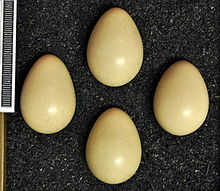
A partridge is a medium-sized galliform bird in any of several genera, with a wide native distribution throughout parts of Europe, Asia and Africa. Several species have been introduced to the Americas. They are sometimes grouped in the Perdicinae subfamily of the Phasianidae. However, molecular research suggests that partridges are not a distinct taxon within the family Phasianidae, but that some species are closer to the pheasants, while others are closer to the junglefowl.

The common gull or sea mew is a medium-sized gull that breeds in the Palearctic. The closely related short-billed gull is sometimes included in this species, which may be known collectively as "mew gull". Many common gulls migrate further south in winter. There are differing accounts as to how the species acquired its vernacular name.

The grey partridge, also known as the gray-legged partridge, English partridge, Hungarian partridge, or hun, is a gamebird in the pheasant family Phasianidae of the order Galliformes, gallinaceous birds. The scientific name is the Latin for "partridge", and is itself derived from Ancient Greek perdix.
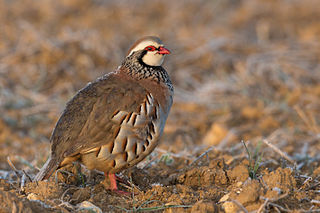
The red-legged partridge is a gamebird in the pheasant family Phasianidae of the order Galliformes, gallinaceous birds. It is sometimes known as French partridge, to distinguish it from the English or grey partridge. The genus name is from Ancient Greek alektoris a farmyard chicken, and rufa is Latin for red or rufous.

The rufous-bellied eagle or rufous-bellied hawk-eagle is a bird of prey in the family Accipitridae that is found in the forested regions of tropical Asia. Relatively small for eagles and contrastingly patterned like a falcon, this species was earlier placed in the genus Hieraaetus and sometimes also in the genus Aquila but thought to be distinctive enough to belong to a separate genus.

The hazel grouse, sometimes called the hazel hen, is one of the smaller members of the grouse family of birds. It is a sedentary species, breeding across the Palearctic as far east as Hokkaido, and as far west as eastern and central Europe, in dense, damp, mixed coniferous woodland, preferably with some spruce. The bird is sometimes referred to as "rabchick" by early 20th century English speaking travellers to Russia.

The rufous-browed peppershrike is a passerine bird in the vireo family. It is widespread and often common in woodland, forest edge, and cultivation with some tall trees from Mexico and Trinidad south to Argentina and Uruguay.

Perdix is a genus of Galliform gamebirds known collectively as the 'true partridges'. These birds are unrelated to the subtropical species that have been named after the partridge due to similar size and morphology.

The Tibetan partridge is a gamebird in the pheasant family Phasianidae of the order Galliformes. They are found widely across the Tibetan Plateau and have some variations in plumage across populations. They forage on the ground in the sparsely vegetated high altitude regions, moving in pairs during the summer and in larger groups during the non-breeding season. Neither males nor females have spurs on their legs.

The chestnut-bellied partridge also known as chestnut-bellied hill-partridge or Javan hill-partridge is a small, up to 28 cm long, partridge with a rufous crown and nape, red legs, grey breast, brown wings, red facial skin, and a black mask, throat and bill. It has a rufous belly with white on the middle. The sexes are similar. The young has a whitish face and a reddish brown bill.

The handsome spurfowl is a species of bird in the pheasant family Phasianidae. It is a large, up to 35 cm long, terrestrial forest bird with a dark reddish brown plumage, grey head, red bill and legs, brown iris, bare red orbital skin and rufous grey below. Both sexes are similar. The female is slightly smaller than male. The young has duller plumage.
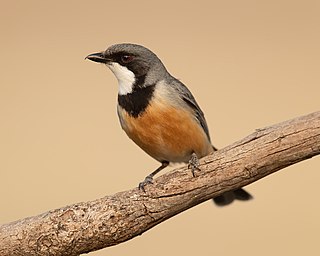
The rufous whistler is a species of whistler found in New Caledonia and Australia. Predominantly a reddish-brown and grey bird, it makes up for its subdued plumage with its song-making ability. Like many other members of the Pachycephalidae, it has a variety of musical calls.
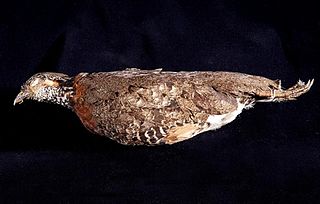
The chestnut-necklaced partridge is a species of bird in the family Phasianidae. It is found in forests in the Malay Peninsula and Sumatra. It is threatened by habitat loss and trapping. The International Union for Conservation of Nature (IUCN) has assessed it as vulnerable.

The red-breasted partridge, also known as the Bornean hill-partridge, is a species of bird in the family Phasianidae. It is endemic to hill and montane forest in Borneo, preferring bamboos and thickets. The International Union for Conservation of Nature (IUCN) has assessed it as a least-concern species.

The grey-breasted partridge, also known as the white-faced hill partridge, or Horsfield's hill partridge, is a bird species in the family Phasianidae.
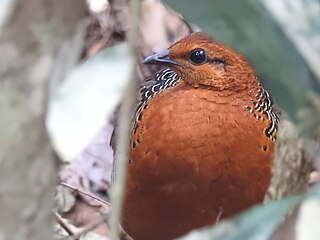
The ferruginous partridge is a species of bird in the family Phasianidae. It belongs to the monotypical genus Caloperdix. It is found in Indonesia, Malaysia, Myanmar, and Thailand.

The Mount Cameroon spurfowl is a bird species in the pheasant family Phasianidae. It is found only in Cameroon.

The grey-breasted spurfowl or grey-breasted francolin is a species of bird in the family Phasianidae. It is found only in Tanzania.

Hume's short-toed lark is a species of lark in the family Alaudidae. It is found in south-central Asia from Iran and Kazakhstan to China.

Perdicinae is a polyphyletic former subfamily of birds in the pheasant family, Phasianidae, regrouping the partridges, Old World quails, and francolins. Although this subfamily was considered monophyletic and separated from the pheasants, tragopans, junglefowls, and peafowls (Phasianinae) till the early 1990s, molecular phylogenies have shown that these two subfamilies actually constitute only one lineage. For example, some partridges are more closely affiliated to pheasants, whereas Old World quails and partridges from the Alectoris genus are closer to junglefowls. Due to this, the subfamily Perdicinae is no longer recognized by the International Ornithological Congress, with the species being split among 3 subfamilies.


